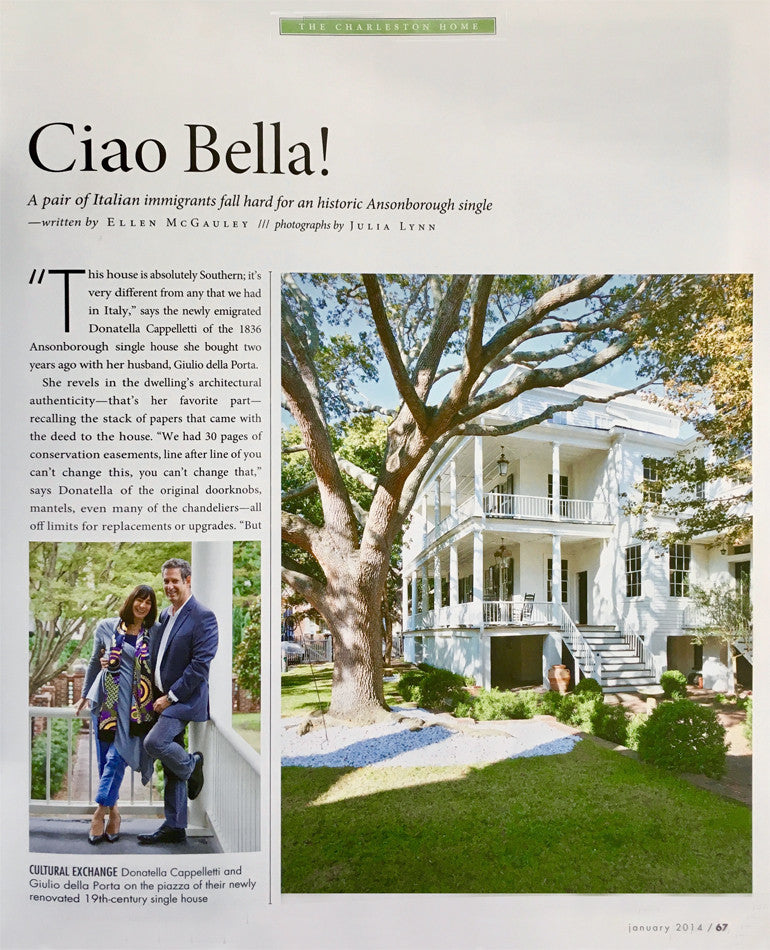This house is absolutely Southern; it’s very different from any that we had in Italy,” says the newly emigrated Donatella Cappelletti of the 1836 Ansonborough single house she bought two years ago with her husband, Giulio della Porta.
She revels in the dwelling’s architectural authenticity—that’s her favorite part—recalling the stack of papers that came with the deed to the house. “We had 30 pages of conservation easements, line after line of you can’t change this, you can’t change that,” says Donatella of the original doorknobs, mantels, even many of the chandeliers—all off limits for replacements or upgrades. “But we like that. It’s one of the main reasons we bought this house. It’s very true.”
They should know. Old houses are, after all, old hat to Giulio—the architect has renovated and restored more than 30 dwellings in the rural valley of his native Umbria, many dating as far back as 1600. “I looked for buildings in ruins,” says Giulio. “The houses in the valley of Montone—all built of hand-shaped stone—were mostly abandoned, some for more than a century.”
“He loves this work,” says Donatella, a newspaper journalist turned boutique owner (the pair owns The Hidden Countship on Burns Lane downtown) who met Giulio in 2002 when a book was published about his family, a local aristocracy. “I needed to interview this man, a count who lived on the mountain,” she laughs. “Of course, I pictured this horrible old man with big round glasses. I tried to get out of it, but… I went. And that was Giulio.”How the count and his journalist bride ended up in Charleston is similarly accidental. In 2009, Donatella and Giulio planned their first trip to the States. But instead of following the well-beaten transatlantic path to hubs like New York or Boston, they embarked on a 900-mile driving tour of the Old South, visiting plantations along the Mississippi River and the Gulf Coast and along the Golden Isles in Georgia. “Charleston wasn’t in our plans, but we added it in on the recommendation of someone we met along the way,” recalls Donatella. “We were here for just one day, walking the downtown streets, and fell in love.”
Over the next couple of years, the pair looked at a number of historic houses on the peninsula—and even bought one short-term on Philadelphia Alley—but it was this Greek Revival charmer on Laurens that got their preservationist hearts racing. Built by New England transplant Augustus Taft (of the same bloodline as former president William Taft), it’s one of the few surviving “transitional” dwellings of the era—Federal or Adamesque styles were beginning to give way to more classical themes (for example, the modified Greek Key detailing at the entrance). Taft handed the house down to his daughter; she married into Charleston’s notable Stoney family, with whom the dwelling remained for more than a century, with the exception of six months after the Civil War when the federal government seized it to house a number of freed slaves.
Though the home underwent a few changes shortly after it was built, most of what remains is original: the romantic double piazzas, ornate plaster cornices and
ceiling medallions, and—most stirring to Donatella and Giulio—Italian marble mantels in three downstairs fireplaces.“It’s incredible to us that someone in the 1830s wrote to someone in Italy—likely a few villages over from us, in La Spezia—and asked specifically for this black Portoro marble with gold veining,” Donatella says. (Incidentally, the builder used the same marble at Millford Plantation in Pinewood, South Carolina.)
You might call it a kinship, this relationship the pair quickly developed with the 19th-century dwelling. Giulio jumped right in, whipping the house into shape in a
few short months. “He is a man of ‘now,’” Donatella laughs. “He loves this, and he doesn’t wait.”Made of strong black cypress, it was structurally sound, so the work ahead of them was mainly cosmetic (the siding sagged, the shutters brittle and rotting, and inside, cracked plasterwork and floors were in need of mending). But they also set out to undo some 20th-century alterations. “The staircase was painted, so we brought the wood back to its original finish,” she says. In the kitchen, Giulio removed low ceiling tiles to reveal the room’s slanted wood roofline. “Kitchens in the Umbrian countryside have a particular warmth, and exposing the original wood brought in some of that,” says Donatella, who also commissioned the building and painting of a new kitchen island to mimic the patina and design of an antique Italian wine cabinet along the far wall.
More vestiges of their home country followed: a hand-painted dining table designed after 14th-century Umbrian and Tuscan furnishings, a collection of drawings entitled “Costumes in Rome” by 18th-century artist Giovanni Battista Cipriani, a circa-1700 Italian walnut Piemontese dresser, and more. Interwoven are choice pieces they’ve picked up that speak of their new home, like a large painting of a fruit cellar by John Carroll Doyle.
This gradual weaving of Southern soul into their classic collection is right in line with Donatella and Giulio’s philosophy. “You can’t describe in words what you need around you, those things that speak of you,” says Donatella. “But your house does, and should, speak so much about you.”


